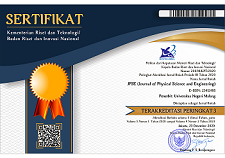Reduced Graphene Oxide/Polyvinyl Alcohol Nanofibers Fabricated by Electrospinning Technique as An Ideal Candidate for Organic Solar Cell Devices
Abstract
Functionalization of rGO that previously obtained by chemical reduction using hydrazine hydrate, has been done by changing its morphology into nanofiber with electrospinning technique and using PVA as a polymer matrix. The rGO nanofibers that had been formed were then characterized using Fourier Transformation-Infra Red (FTIR) spectroscopy, Scanning Electron Microscopy (SEM), and UV-Vis Spectrophotometer. FTIR spectroscopy confirmed the presence of C – C group and C = O group in nanofibers. SEM showed the change of nanofibers morphology which is marked by the increasing of fibres diameter and the hollow fibres become brighter. Furthermore, the effect of rGO concentration to nanofiber optical properties was confirmed by UV-Vis spectrophotometer. According to this characterization, the absorbance of rGO/PVA nanofiber is decreased due to increased rGO concentration. The detail of optical properties of rGO is studied through complex refractive index and dielectric constant in which Kramers-Kronig transformation is then employed to calculate complex refractive index and complex dielectric constant. From the data, the optical properties of rGO/PVA nanofibers indicating that rGO/PVA nanofibers can be applied as transparent electrode an organic solar cell devices.
Keywords
Full Text:
PDFReferences
B. Mortazavi et al., “Nanoporous graphene: A 2D semiconductor with anisotropic mechanical, optical and thermal conduction properties,” Carbon N. Y., vol. 147, pp. 377–384, 2019.
S. N. Alam, N. Sharma, and L. Kumar, “Synthesis of graphene oxide (GO) by modified Hummers method and its thermal reduction to obtain reduced graphene oxide (rGO),” Graphene, vol. 6, no. 1, pp. 1–18, 2017.
J. G.-Contreras and F. C.-Briones, “Graphene oxide powders with different oxidation degree, prepared by synthesis variations of the Hummers method,” Mater. Chem. Phys., vol. 153, pp. 209–220, 2015.
M. I. Katsnelson, Graphene: Carbon in Two Dimensions. Cambridge, USA: Cambridge University Press, 2012.
K. Parvez et al., “Exfoliation of graphite into graphene in aqueous solutions of inorganic salts,” J. Am. Chem. Soc., vol. 136, no. 16, pp. 6083–6091, 2014.
K. Parvez, S. Yang, X. Feng, K. Mullen, “Exfoliation of graphene via wet chemical routes,” Synthetic Met., vol. 210, pp. 123–132, 2015.
Y. Wei et al., “Epitaxial growth of single-domain graphene on hexagonal boron nitride,” Nature Mater, vol. 12, no. 9, pp. 792–797, 2013.
H. Ago et al., “Epitaxial growth and electronic properties of large hexagonal graphene domains on Cu(111) thin film,” Appl. Phys. Express, vol. 6, no. 7, p. 075101, 2013.
X. Yang et al., “Chemical vapour deposition of graphene: layer control, the transfer process, characterization, and related applications,” Int. Rev. Phys. Chem., vol. 38, no. 2, pp. 149–199, 2019.
H. Zhou et al., “Chemical vapour deposition growth of large single crystals of monolayer and bilayer graphene,” Nat. Commun., vol. 4, no. 1, pp. 1–8, 2013.
S. Some et al., “High-quality reduced graphene oxide by a dual-function chemical reduction and healing process,” Sci. Rep., vol. 3, no. 1, pp. 1–5, 2013.
F. T. Thema et al., “Synthesis and characterization of graphene thin films by chemical reduction of exfoliated and intercalated graphite oxide,” J. Chem., vol. 2013, pp. 1–6, 2013.
S. V. Tkachev et al., “Reduced graphene oxide,” Inorg. Mater., vol. 48, no. 8, pp. 796–802, 2012.
L. Stobinski et al., “Graphene oxide and reduced graphene oxide studied by the XRD, TEM and electron spectroscopy methods,” J. Electron Spectroscopy and Related Phenomena, vol. 195, pp. 145–154, 2014.
H. Feng, R. Cheng, X. Zhao, X. Duan, and J. Li, “A low-temperature method to produce highly reduced graphene oxide,” Nat. Commun., vol. 4, no. 1, pp. 1–8, 2013.
N. Cao and Y. Zhang, “Study of reduced graphene oxide preparation by Hummers’ method and related characterization,” J. Nanomat., vol. 2015, pp. 1–5, 2015.
K. W. Mas’udah, A. Taufiq, and Sunaryono, ”A study on phase and microstructure of reduced graphene oxide prepared by heating corncobs,” JPSE (J. Phys. Sci. Eng.), vol. 5, no. 2, pp. 66–70, 2020.
B. Luo, S. Liu, and L. Zhi, “Chemical approaches toward graphene-based nanomaterials and their applications in energy-related areas,” Small, vol. 8, no. 5, pp. 630–646, 2012.
D. Zhang, F. Xie, P. Lin, and W. C. H. Choy, “Al-TiO2 composite-modified single-layer graphene as an efficient transparent cathode for organic solar cells,” ACS Nano, vol. 7, no. 2, pp. 1740–1747, 2013.
G. H. Jun et al., “Enhanced conduction and charge-selectivity by n-doped graphene flakes in the active layer of bulk-heterojunction organic solar cells,” Energy Environ. Sci., vol. 6, no. 10, pp. 3000–3006, 2013.
S. Das et al., “Electrospinning of polymer nanofibers loaded with noncovalently functionalized graphene,” J. Appl. Polym. Sci., vol. 128, no. 6, pp. 4040–4046, 2013.
A. W. Rokmana et al., “The optical properties of thin film reduced graphene oxide/poly (3,4 ethylenedioxtriophene): poly (styrene sulfonate) (PEDOT:PSS) fabricated by spin coating,” J. Phys.: Conf. Ser., vol. 1011, no. 1, p. 012007, 2018.
H. Suhendar, A. Kusumaatmaja, K. Triyana, and I. Santoso, “Effect of chemical reduction temperature on optical properties of reduced graphene oxide (rGO) and its potentials supercapacitor device,” Mat. Sci. Forum, vol. 901, pp. 55–61, 2017.
J. Chen, B. Yao, C. Li, and G. Shi, “An improved Hummers method for eco-friendly synthesis of graphene oxide,” Carbon, vol. 64, pp. 225–229, 2013.
M. Fox, Optical Properties of Solids. New York: New Oxford University Press, 2001.
L. Shahriary and A. A. Athawale, “Graphene oxide synthesized by using modified Hummers approach,” Int. J. Renewable Energy and Env. Eng., vol. 2, no. 1, pp. 58–63, 2014.
B. Q. Bao et al., ”Graphene-polymer nanofiber membrane for ultrafast photonics,” Adv. Funct. Mater., vol. 20, no. 5, pp. 782–791, 2010.
L. Jin et al., “Fabrication, mechanical properties, and biocompatibility of reduced graphene oxide-reinforced nanofiber mats,” RSC Adv., vol. 4, no. 66, pp. 35035–35041, 2014.
Copyright (c) 2021 Asriani Asriani, Iman Santoso

This work is licensed under a Creative Commons Attribution-ShareAlike 4.0 International License.
This work is licensed under a Creative Commons Attribution-ShareAlike 4.0 International License




















